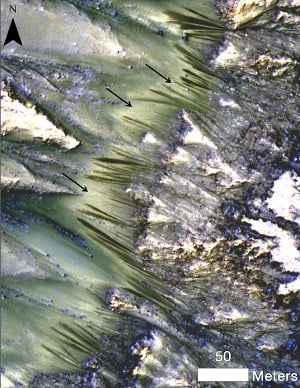This article is more than 1 year old
Boffin talks WATER on MARS: Granted, no 'smoking gun', but all clues flow there...
Water, water, might be everywhere, but we can't spot it
Images of dark markings on the surface of Mars that appear to flow as the planet experiences seasonal changes have given boffins the strongest indication of possible liquid water on the planet, but it's proving difficult to come up with conclusive proof.

The dark streaks that appear and disappear on the Red Planet, which the scientists refer to as "recurring slope lines" (RSL), are being studied for the minerals they might leave in their wake that could prove one way or another if they're water-related.
"We still don't have a smoking gun for existence of water in RSL, although we're not sure how this process would take place without water," said Lujendra Ojha, a graduate student at the Georgia Institute of Technology and lead author of two new reports about these flows.
Ojha originally discovered the lines in images from the High Resolution Imaging Science Experiment (HiRISE) camera on NASA's Mars Reconnaissance Orbiter and has since been analysing 13 confirmed RSL sites with images from the MRO's Compact Reconnaissance Imaging Spectrometer for Mars (CRISM).
But so far, Ojha and his team haven't been able to find any spectral signature related to water or salts. What they did find was distinct and consistent signatures of ferric and ferrous minerals at most of the sites.
"Just like the RSL themselves, the strength of the spectral signatures varies according to the seasons. They're stronger when it's warmer and less significant when it's colder," Ojha said.
These minerals could be left behind in a sorting of grain size process that removes fine dust from the surface, but that could be either a wet process or a dry one. It's also possible that the signatures are an increase in the more oxidised component of the minerals or an overall darkening due to moisture, both of which point to the presence of water.
But scientists can't be sure. The leading hypothesis for RSL is the flow of near-surface water, kept liquid by salts that are depressing the freezing point. CRISM could have missed the water because the dark flows are so much narrower than the area the instrument samples with each reading or it could be because the observations were made in the afternoons, missing morning moisture.
In related research, boffins used the MRO and NASA's Mars Odyssey orbiter to look for patterns in where and when the seasonal flows pop up, but only found 13 confirmed sites out of 200 ideal locations for RSL formation.
"The fact that RSL occur in a few sites and not others indicates additional unknown factors such as availability of water or salts may play a crucial role in RSL formation," Ojha said.
The RSL are also more abundant in some years than in others, making them harder to track.
"NASA likes to 'follow the water' in exploring the Red Planet, so we'd like to know in advance when and where it will appear," said Georgia Tech assistant professor James Wray. "RSL have rekindled our hope of accessing modern water, but forecasting wet conditions remains a challenge." ®
